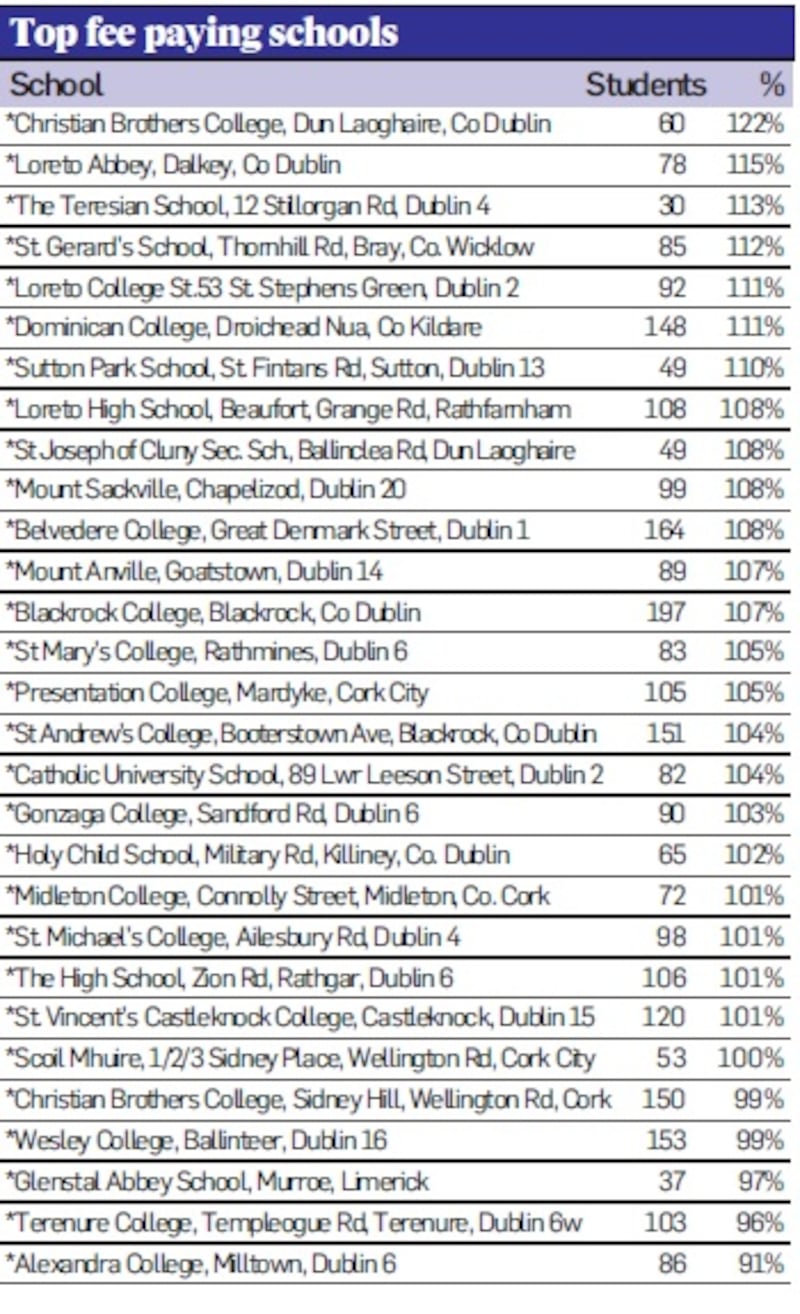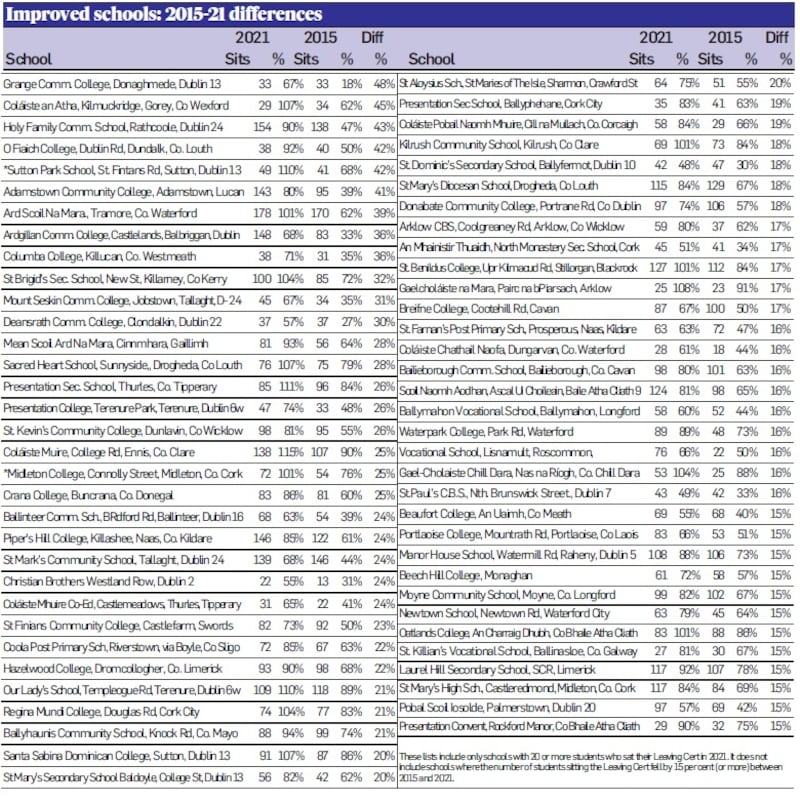Most students in a sample of schools which had a low progression rate to third level but who went on to attend a Further Education (FE) college are progressing on to further education in high numbers, according to the results of a pilot study carried out by The Irish Times.
The study also shows that every student in the sample is going on to either further or higher education, with many further education students ultimately securing third level places and outperforming those who enter college immediately after school.
This is the first year that The Irish Times has been able to access the progression data for a Further Education and Training college and, while it comes from just one college of further education, the combined figure for further and higher education progression data means that, today, these schools are given full credit for every student who continues their studies.
More than 90 per cent of eligible students at Dunboyne College of Further Education (DCFE) who applied to the CAO in 2021 received – although may not have accepted – an offer for a level seven or eight college course, with 115 going on to Maynooth University, 126 progressing to a level seven at TU Dublin and 60 progressing to a level eight at TU Dublin.
Smaller numbers of DCFE graduates attended other universities, technological universities, institutes of technology and colleges across the country.
DCFE's intake includes students primarily from schools in Meath, north Kildare and west Dublin.
Analysis
An analysis of data provided by third level institutions to The Irish Times, meanwhile, shows an exponential rise in the numbers progressing from further to higher education, as a result of Minister for Further and Higher Education Simon Harris's policy to build better connections between the two sectors.
The numbers attending TU Dublin from Rathmines CFE, for instance, have surged from three last year to 33 this year, with the numbers officially recorded from DCFE, Dún Laoghaire CFE and Pearse College, to name but a few, rising from zero to, respectively, 62, 24 and six.
The Education Indicators for Ireland report, jointly published by the Department of Education and the Department of Further and Higher Education, Research, Innovation and Science, shows that numbers opting for apprenticeships has risen from 10,445 in 2016 to 19,630 in 2020.
Further education insiders and policymakers, speaking on and off the record, have expressed concern that feeder school tables, which to date have been unable to include FE data, do not reflect students who choose the Further Education and Training option as either a bridge to third level or a work-ready qualification in its own right.
To date, apprenticeships and further education have been excluded from the annual lists primarily because the information is not systematically gathered, making it impossible to collect from every college of further education.
Across the FE sector, some efforts are being made to systematically gather this data, but questions remain as to whether the Department of Education would block its full release and thus prevent schools from getting full credit and acknowledgement for every one of their students who goes on to continue their studies.
The Irish Times understands that, because further education is technically considered as “second level”, this decision would rest with the Department of Education and not the Department of Further and Higher Education.
"[Feeder schools] is one of the only publicly available means by which the relative student outcomes of a school can be tangibly measured, albeit in a way that considers those outcomes via only one lens that doesn't take into account the many contributory factors to the school experience," Andrew Brownlee, chief executive of Solas, the further education and training agency, that oversees apprenticeships, traineeships and post-Leaving Cert courses, told The Irish Times.
“If there is to be a focus on school-leaver destinations, it should consider all of these destinations, covering further and higher education and apprenticeships. It is also important that these options are not considered purely as either/or scenarios. There is strong evidence that taking a further education course prior to entering higher education prepares students well and gives them a better chance of completing their degree.”
Study options
Brownlee said that parents need information on the diverse study options available in these schools, including access to more technical and vocational disciplines and experiences that will prepare students for a wider range of potential pathways.
The existence of feeder-school tables, published today by The Irish Times, Irish Examiner and Irish Independent, has made some schools reluctant to send students on to FE, said Denis Leonard, principal of DCFE.
“We made the decision to release our data because there is pressure on schools to show where their students are going. Counting FE will give those schools credit, and we know that the longer someone stays in education, the better job they will get. There has been a sea change in how PLCs are seen. Once they were a back-up; now they are a first choice for students of all abilities who want a year to figure out what they’re going to do, to get a taste of a college course, or to get a work qualification that doesn’t require a third-level degree, in areas including but not limited to animal care, childcare and hairdressing.”
Leonard said that parents are beginning to see the value of the courses when they hear of students who started in FE, went to higher education and came out with a higher degree.
Data from Solas shows that students with under 300 points have a 50 per cent chance of completing a higher-education degree, but this increases to 75 per cent for those who have gone through a FE course first.
“FE students learn referencing, research and self-directed learning which means they tend to be able to complete subsequent level seven or eight degree courses,” said Leonard.
Overall third level dropout rates for students who do a level five QQI course are less than 3 per cent, compared to up to 10 per cent in universities and at least 33 per cent in some institute of technology courses, especially computing.
Looking at the main charts published today – where further education progression could not be included due to the sector’s failure to gather and release it – some familiar themes emerge.

Fee-paying advantage
Students who attend fee-paying schools appear to have a continued advantage in accessing third-level places, particularly for high-points courses, taking 15 of the top 16 spots on this list; all bar the fee-paying, all-boys school Belvedere College and co-educational Sutton Park School (which are, respectively, in north inner city Dublin and north county Dublin) are in south Dublin. The only non-fee paying school in the top 10 is Muckross College in affluent Donnybrook, Dublin 4.
Record grade inflation, which in turn led to a surge in CAO points that saw many students with high points, appears to have had a more negative impact on non-fee paying schools, disadvantaged schools and schools in more rural areas.
Overall, the performance of non-fee paying schools is down somewhat from last year.

While the very top schools in each county have generally seen third level progression rise compared to last year, it is down for a handful of schools who saw progression rates between 40 and 80 per cent in 2020 and who generally send less students to third level than the "best-performing" schools, in Cavan, Kerry, parts of Kildare, Kilkenny, Laois, Leitrim, Limerick, Longford, Meath, Offaly, Sligo, parts of Tipp- erary, Waterford, Westmeath and Wexford.
In Dublin and Cork, this phenomenon is notably less pronounced, where some of the fee-paying schools have, if anything, tightened their grip.
This is in contrast to last year, which saw schools award a calculated grade based on their work in school instead of the usual written exam, as a result of the pandemic, with students in disadvantaged schools performing better than usual. With a report on Leaving Cert reform sitting on the Minister for Education’s desk, this may strengthen the argument that the Leaving Cert as it currently stands benefits the most advantaged students.
Some Monaghan schools have seen particular falls in third level, but this may be because students in Border counties are traditionally more likely to choose UK and Northern Ireland colleges, and perhaps more so this year as a result of rising CAO points; our lists do not capture those who study in Northern Irish colleges (except UU and Queen's), in the UK or in European colleges.












